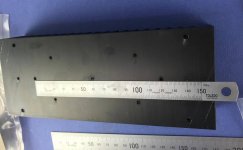pretty much everything explained here : http://www.firstwatt.com/pdf/art_amp_camp_1.pdf
later iterations are just that - iterations of same thing
later iterations are just that - iterations of same thing
Would you please tell me more about that new ACA amp?
Amp Camp Amp - Complete Kit – diyAudio Store
Best,
Anand
Are bridged ACA amps suitable for driving Quad ESL-988s (or ESL-63) electrostatic speakers?
I'm going to bet not.
On my 1.6 heatsinks, the main board mounting hole centres are on the corners of a rectangle 80mm x 40mm. The two MOSFET mounting holes (1 off for each MOSFET) are 120mm apart, equispaced along the "long" centreline of the board mounting holes. There is also an extra hole in the dead centre of the heatsink and of all the other holes. Happy to post a pic if that helps...
Cheers,
Matt
Cheers,
Matt
Attachments
Thanks Anand. I had a look, I guess it's best into 8 ohms but will drive as low as 4 ohms?
Cheers,
Matt.
Matt,
Yes. For the standard version of the ACA (ie RCA input, not XLR and not monoblocks).
Do understand that this amp like Nelson’s Aleph J uses a single ended output stage and is Class A. Always. It never shifts into Class AB. Power output will obviously be current limited into lower impedances. This is why it is 7-8 watts into 8 ohms but only about 4-5 watts into 4 ohms. I would encourage buyers to consider the 24V supply to maximize the power output.
That being said, I recently tested it last night into an inefficient “boom box Sony” which has an impedance nadir of 3.2 ohms. Nothing bad happened. No explosions or fireworks. It played music. Not very loud of course but that has more to do with the overall gain of the amp being only ~ 11 dB on my measurements. The source was direct from an Oppo 203, ie, no preamp. Frankly, I am a little surprised that all this sound is coming from a pcb that has parts that amount to USD $14/board.
Some other specs from my build:
- Overall gain: 11 dB (100mV AC input puts out about 355 mV output)
- Input impedance: 10k ohms
- Output impedance: 0.8 ohms
- DC on output (with inputs shorted): 1-2mV
- Temperatures on various parts of chassis are about 107 deg F to 115 deg F. This is after 30min of warm up and some play time.
Best,
Anand.
What impedance is the standard ACA (1.6) happy to drive into without becoming upset, and what will let go if it is pushed too hard or accidentally shorted? Still waiting of mine to arrive, looking forward to it
Regards,
Matt
Shorting the output should not cause any issue because there's C1 if the amplifier is "idling".
With full AC swing at its input and short at its output, the voltage drop across R1 and R2 (it's a single R of approximately 23.5 ohms) will increase the Q3 base voltage, make it conduct more and therefore reduce the voltage across C2 -> hence, the bias current would drop; and I expect it to drop below cut-off voltage if there's a "dead-short", so the Q2 MOSFETs will go into non-conducting state, and as the result, the Q1 current will disappear, making it incapable of amplifying any AC signal.
The same mechanism will "reduce" the power into 4 ohms speakers.
I'm politely asking the ACA Brain Trust (Mr Pass, Mighty ZM and other's who are the experts in this filed) to check what I wrote above... it might be wrong...
Last edited:
Hi Matt,
Thanks for the info on the hole spacing. Exactly what I needed - appreciated!
Cheers,
Bolke
Aren't the current generation ACA heat sinks meant to be part of the UMS standard hole spacing?
When I looked at the store site, I could see from the UMS spec drawing a bunch of PCBs noted but not the ACA. Did I just miss the obvious?
Like Zer0p0intZer0, I'm confused about where to use the heavier gauge hookup wire (red and black in my supplied kit, although the pictures provided recently show blue and black heavy wires). I would think (and it LOOKS like) that the heavier gauge wire should be used for the power supply distribution and for the output to the speaker terminals. And it looks like the red, green, blue and white smaller gauge wires should be used for everything else. It would be good to know what the gauges are in case we have to go out and find more wire (or if we want to customize the colors we use for particular parts of the circuit).
- Home
- Amplifiers
- Pass Labs
- Amp Camp Amp - ACA

